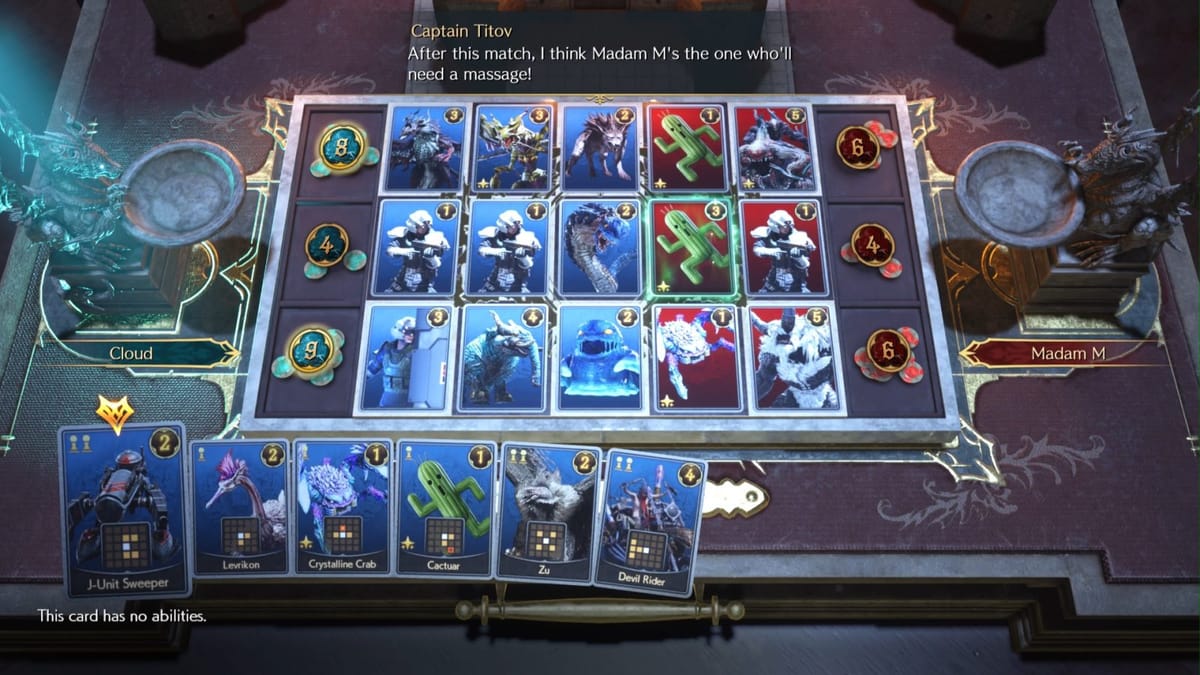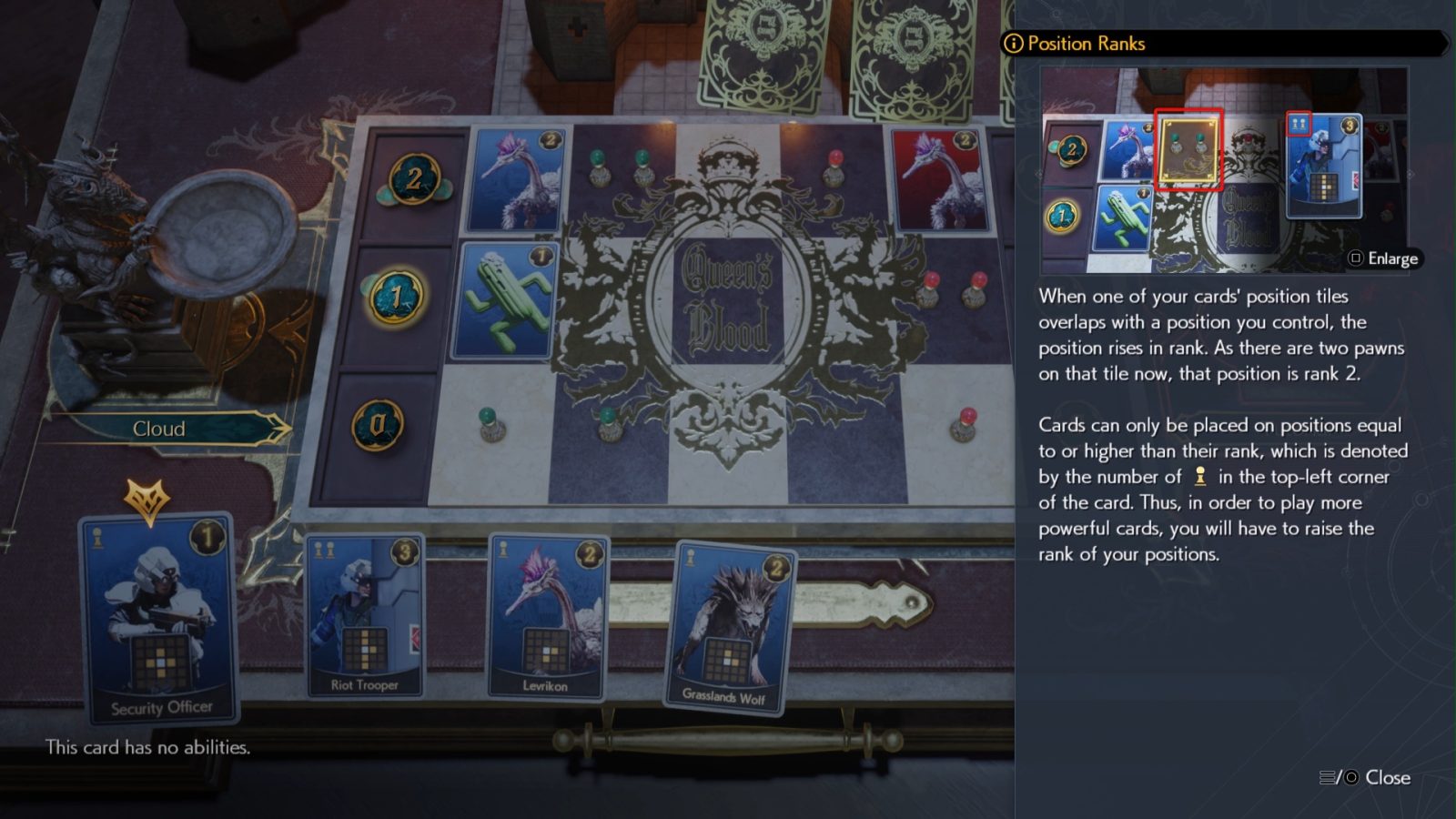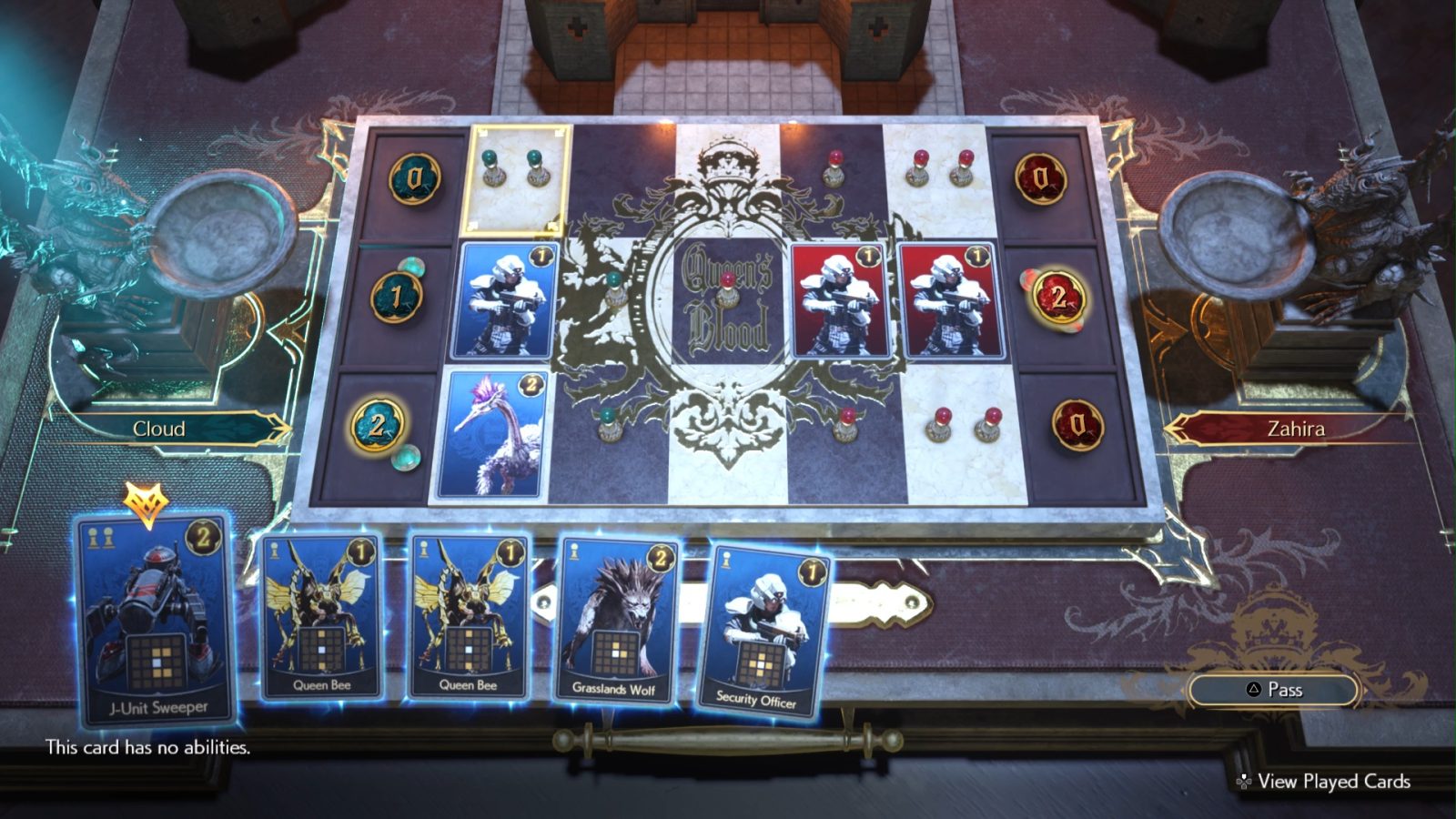
Final Fantasy VII Rebirth is truly about to give the Yakuza series a run for its money with the endless buffet of minigames it offers. The most substantial one that you probably already heard of is none other than Queen’s Blood, a collectible card game that takes place on a deceivingly simple 3×5 grid board. Across your journey throughout Gaia, you’ll collect hundreds of unique cards and battle dozens of worthy opponents in hopes of being crowned the King of Queen’s Blood!
Alright so how do you play? It’s a 1v1 scenario where each player takes turns placing a card based on Final Fantasy monsters from their hand onto one of three horizontal lanes. Who doesn’t want to play a Malboro or Tonberry against their enemy? The catch is: you can only place cards that you have jurisdiction over, as indicated by green orbs in each card slot for you and red orbs for your opponent. The game ends when neither player can play any more cards from their respective hands and the score is tallied up from each of the aforementioned three horizontal lanes.
Scores are calculated in each lane by adding up the total value of each card in that lane. You can keep track by looking at the total points on each side of the board. However, only the player with the winning score in each lane will have their score counted towards the total, meaning if you scored 5 points in the first lane and your opponent scored 6 points, they will get all 6 points added to their total score and you will get 0. Bummer… am I right?
Cards contain a pawn icon on the top left corner, which indicates their rank and a value number on the top right corner. The pawn icon indicates how many green orbs you need to have on a given spot before you can place it. For example, if you have a rank 2 pawn card but only rank 1 orb slots, then you can’t play that card from your hand. So how do you level up the board so that you can place higher ranked cards? Well you’ll have to raise the rank of your positions by playing weaker cards first.

This is where the spatial relationship of the gridboard comes in. Each card contains a gridded diagram in the middle, indicating its functionality. Yellow squares open up slots on the board or level up existing ones, while red squares tie to the ability of the card you are playing. Certain cards also contain special abilities that activate passively once they are placed on the board, such as: “when this card is played, lower the power of enemy cards on affected tiles by 4 or when destroyed, add the card to your hand instead.”
As you progress through the main game, you’ll meet players all around the world waiting to challenge you. Should you come out victorious, they will give you new cards for your collection, and your overall player rank will increase. In order to continue climbing the ranks, you will need to seek out especially difficult foes called “Keepers of the Cruor.” Although the majority of Queen’s Blood battles are optional, they are incorporated quite naturally into the flow of the narrative.

What’s interesting about Queen’s Blood is that it starts off relatively simple but the game starts throwing more interesting mechanics in with unique cards and rules. For example, you can mulligan cards at the start of each round, meaning you can put cards back into your deck and draw new cards before the game even starts. You’ll want to do this if your initial hand is full of high ranking cards that you can’t play anyways.
The two other mechanics that I want to touch upon are enfeeblement and replacement. Certain cards can reduce the power of others on the board, and when a card’s level is reduced to zero, it is destroyed and the position on the board becomes neutral again. Other cards are specifically called replacement cards, meaning you cannot place them on the board naturally, as they can only be played on top of pre-existing cards in order to replace them. The potential benefits of replacement cards are that they do not require a rank to play and they can trigger the abilities of the cards they are replacing since they are destroyed.
There’s an incredible amount of depth and replayability here, with multiple unique decks of cards to play around. Do you want to focus one solely on destroying cards and activating those effects? Or hone in on cards that boost pre-existing cards on the board? Each deck is composed of 15 cards and the game even offers convenient pre-built decks for you to experiment with, should you have the cards for it. Always be on the lookout for vendors and players so that you can collect as many cards as you can!
By now you should have a general idea of what a game of Queen’s Blood looks like, so here are six useful tips to get ahead of any opponent that might stand in the way of victory:
- You will always be the starting player in a game of Queen’s Blood, but that’s not always a good thing. It’s actually sometimes better to press Triangle to pass your turn to the opponent to see their moves first before going. Playing reactively proves to be a better strategy here as you can usually overtake their jurisdiction spots so that you can dominate the board.
- This might be a no-brainer, but take your time to read what each card does before adding it to your deck. Some cards simply don’t synergize well with each other, and may cause you to lose if picked carelessly. Make sure your deck has a good mix of rank 1, rank 2, and rank 3 cards, as you don’t want to end up with a hand of cards you can’t play!
- You’ll get a card pretty early on called the Capparwire that is essentially the best first card to play on the board as it provides 3 points in value and opens up the rest of the lanes for you. It’s strictly better than the Security Officer in that sense (which only offers 1 point), but be wary that the Capparwire lowers the power of allied and enemy cards if you play it when the board is more full.
- Queen’s Blood is a very balanced game, meaning you can technically win every battle with just the pre-built Starter Deck. It might take you a few tries on tougher opponents, but if you don’t want to dive deep into the synergies of different cards then rest assured: the basic cards are enough to carry you through most of the entire game.
- Some cards are straight up terrible as the conditions to play them are difficult to meet and the value they provide is not worth it considering the requirements. For example, Screamer is a 1 value card that requires rank 3 to play and it opens up all the surrounding squares. This means in order to take full advantage of this card, you should play it in the center of the board, which means you need to get that particular slot to rank 3 first, which is simply not worth the effort.
- Your goal should be to dominate the board as quickly as you can. You want the opponent to be able to play the least number of cards possible. This is also why I mentioned in tip #1 that you should let the enemy go first, so you can place your cards strategically to gain jurisdiction in slots on the board so that the opponent is stuck without any slots to play cards on.
And there you have it, a crash course on Final Fantasy VII Rebirth’s newest trading card game! Are you ready to lose yourself to dozens of hours battling it on to become the King of Queen’s Blood? Final Fantasy VII Rebirth launches exclusively for PlayStation 5 on February 29th.
